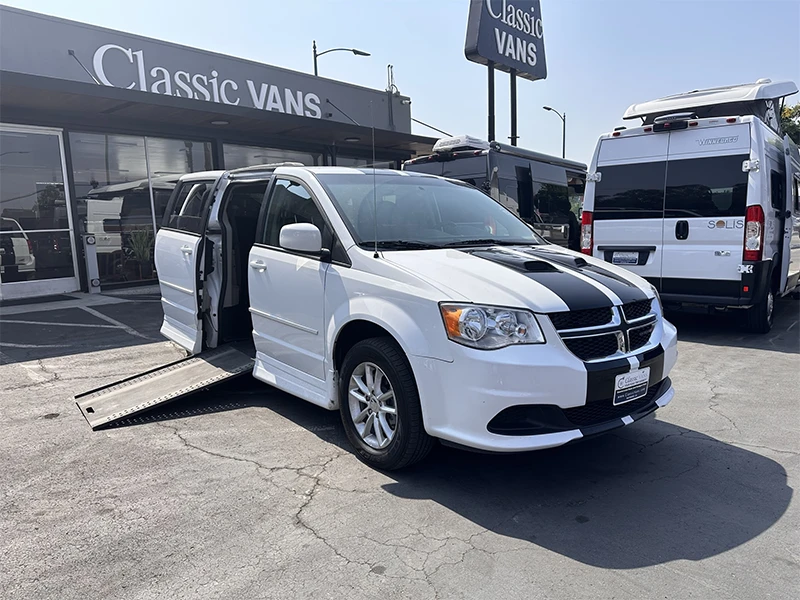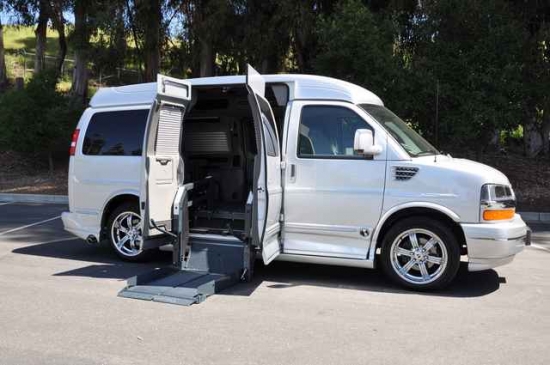
Learn about the unique feature of different Dodge wheelchair-accessible van models
An accessible van is a necessity for anyone who requires a wheelchair for mobility. These vans are specially designed to make transfers easier and commuting more comfortable. Wheelchair users can also experience greater independence when they choose a van that’s equipped to accommodate mobility chairs.
Wheelchair-accessible conversion vans have grown in popularity in recent years, with Dodge handicap vans being among the most sought-after vehicles. The following guide will help wheelchair users, caregivers, drivers and companions differentiate between different models of these vans and understand their unique features.
Side-entry vs. rear-entry wheelchair-accessible vans
Side-entry and rear-entry Dodge handicap vans both offer distinct benefits.
Side-entry handicap vans
Most wheelchair-friendly vans are side-entry, so you’ll have more options when shopping around. A lowered floor gives side-entry vans more room for head clearance when entering and exiting.
These vans are also more likely to have removable front seats, which allow the wheelchair user to sit in the front of the vehicle.
- Direct access to driver or passenger seat. Side entry allows wheelchair users to get closer to the front seats, which is beneficial if the user wishes to drive.
- Easier transfer to front seats. Transferring to the driver or passenger seat is often more straightforward in side entry designs.
- More room for maneuvering. They typically provide ample space for turning and maneuvering a wheelchair inside the van.
- Options for ramp or lift. Fold-out and in-floor ramps, lifts, and center-cut conversions are all available in side-entry models, offering more flexibility.
- Parking and ramp deployment limitations. Finding suitable parking spaces that accommodate the side ramp can be more challenging, especially in crowded urban areas. Side-entry vans also need additional space beside the vehicle, which can be challenging in tight parking spots.
- Reduced seating capacity. The conversion for side entry may reduce the number of available seats inside the van.
Rear-entry handicap vans
Rear-entry vans, on the other hand, feature a rear fold-out ramp and a lower center-cut conversion.
They also generally have more interior space that can accommodate larger or even multiple wheelchairs.
- Parking flexibility. Rear-entry vans don’t require extra space beside the van for ramp deployment, making them convenient in standard parking spaces.
- Often lower cost. Rear-entry modifications can be less expensive than side-entry conversions.
- Accommodates longer wheelchairs and scooters. The straight-back approach provides more room for longer mobility devices.
- Maintains more seating. Rear-entry vans often allow for more of the original seating to remain intact.
- Limited access to driver or front passenger seat. In most rear-entry vans, transferring to the front seats from the wheelchair is more challenging.
- Difficulty in some parking situations. Rear entry ramps can be problematic in parallel parking situations or when another vehicle parks too close behind.
- Potential for traffic exposure. Deploying the ramp into a street or parking lot lane can expose the user to traffic.
Choosing between rear and side entry handicap vans largely depends on the specific needs and preferences of the user, including considerations of wheelchair size, the user’s ability to transfer to seats, and typical parking situations they encounter.
Tips and advice for safely driving and operating a wheelchair van.
Is a ramp or lift better for a wheelchair van?
Choosing between a ramp and a lift for a wheelchair van is often a matter of personal preference, specific needs, and the type of vehicle being used. Below are some considerations to help determine which option might be better for you.
- Cost-effective. Ramps are generally less expensive than lifts.
- Simpler to operate. They are easier to deploy and require less mechanical maintenance.
- Lighter weight. Ramps add less weight to the vehicle, which can be beneficial for fuel efficiency.
- Space-saving. When stowed, ramps typically take up less space inside the vehicle.
- Manual strength required. Manual ramps require some physical effort to deploy and stow.
- Slope and length. Ramps can be steep, depending on the vehicle’s height, which might be challenging for some users.
- Weather sensitivity. Ramps can become slippery and more difficult to use in bad weather conditions like rain or snow.
- Easier for the user. Lifts require minimal physical effort and are easier for individuals with limited strength or mobility.
- Accommodates heavier wheelchairs. They are more suitable for heavier electric wheelchairs or scooters.
- Safer in various weather conditions. Lifts are less affected by weather conditions.
- More vertical space. Beneficial for taller individuals or higher-profile wheelchairs.
- Cost. Lifts are more expensive than ramps, both in initial installation and maintenance.
- Added weight. They add significant weight to the vehicle, which can affect fuel economy.
- Complexity and maintenance. Lifts have more mechanical parts, which means they can require more maintenance and are more prone to mechanical issues.
- Space requirements. Lifts can take up more interior space and may require more clearance space around the vehicle.
Overall, ramps are more cost-effective and simpler to use, but they might present challenges in terms of manual operation and slope. Lifts, while more expensive and heavier, offer ease of use and are better suited for heavier wheelchairs. The choice should be based on the individual’s physical capabilities, type of wheelchair, budget, and vehicle type.
Advancements in technology have made driving with a handicap not only possible, but also safe and easy.
Popular options for Dodge wheelchair van models
Dodge is a leading choice for wheelchair-accessible conversion vans. When choosing a van, you’ll want to consider models with different access points, ramps, and power sources for the van’s accessibility features. Below are some of the most popular options on the market today.
BraunAbility Dodge CompanionVan
The Dodge BraunAbility CompanionVan is available in 3 options: the EasyRamp, Plus, and the Plus XT. Each has:
- A side-entry ramp
- Power Conversion
- A fold-out ramp
True to their name, all CompanionVan models are suitable for wheelchair users who travel with a companion.
- Dodge CompanionVan EasyRamp. The EasyRamp version features a power side-entry conversion that is located in the midsection of the van and has a lowered floor. The front and passenger seats remain static. Because the middle section of the van is the only part that has a lowered floor, the EasyRamp has a more budget-friendly price point compared to other CompanionVans.
- Dodge CompanionVan Plus. In addition to having the lower floor in the midsection, the CompanionVan Plus has removable front seats that allow wheelchair users to ride as a passenger in the front or drive if they prefer. This version of the CompanionVan features a power side-entry ramp that is constructed of lightweight aluminum. The easy-to-use ramp can also be operated manually.
- Dodge CompanionVan Plus XT. The Plus XT offers 56.5 inches of head clearance through the sliding door. An upgraded kneeling system lowers the rear suspension more, thereby creating a lower ramp slope for smoother wheelchair transfer. An open floor plan and removable front seat deliver more flexible seating options.
BraunAbility Dodge Manual Rear-Entry Vans
Ease of use makes Dodge’s Manual Rear-Entry Van stand out from other models. The extra-wide, lightweight 34-inch rear ramp will accommodate the largest wheelchairs.
Because the hatch and bifold ramp are both operated manually, the Manual Rear-Entry Van is most suitable for wheelchair users who always travel with a companion.
Other features include the following:
- The lightweight ramp can accommodate up to 1,000 lbs.
- A second-row seat that folds down also allows a companion to sit next to the wheelchair user.
- The vehicle’s spacious interior can accommodate up to 2 manual wheelchair users.
- Ramp access through the back of the van offers parking flexibility that allows the van to be parked in regular, non-handicap parking spaces.
VMI Dodge NorthStar Vans
The Vantage Mobility International (VMI) NorthStar line of wheelchair-friendly vans is comparatively budget-friendly, with models that are easy to use. NorthStar vans have all the benefits of an in-floor ramp system, including a doorway that is free of obstruction and an uncluttered interior.
Removable front seats allow for multiple seating arrangement options. Passengers who do not require a wheelchair for mobility can easily enter and exit Northstar models without deploying the ramp. Some popular models include:
- VMI Northstar-E Dodge Manual In-Floor. The Manual In-Floor is the lowest-priced of the VMI Northstar vans. These vehicles can accommodate wheelchair users who travel with a companion. Not only is the E Manual In-Floor more affordable than other wheelchair-friendly vans, but it’s uniquely packed with features. It’s the only caregiver van that features front-seat wheelchair access, a manual in-floor ramp that does not require lifting or bending, and space for up to seven passengers.
- VMI Northstar-E Dodge Power In-Floor. The Power In-Floor version combines flexibility and ease of use with affordability. Among its features are an in-floor ramp that allows obstruction-free entrance and exit and an uncluttered interior.
- VMI Dodge Summit. Dodge’s Summit features a durable fold-out ramp that has high side rails for safer, easier wheelchair navigation into and out of the vehicle. A versatile, affordable option, the Summit is suitable for manual wheelchairs and power chairs.
Need help finding your next wheelchair-accessible van? Classic Vans can help!
Established in 1988 and family-operated, Classic Vans has become recognized as America’s premier dealership for new and pre-owned conversion vans, camper vans, RVs, and wheelchair-accessible vehicles.
We have a wide variety of handicap vans and SUVs available with all the latest features, and we’re happy to offer affordable delivery across the country.
Struggling to find the ideal accessible vehicle for you? Our mobility van experts can install hand controls, EZ lock, and various driving aids, customizing them to meet your unique mobility requirements.




